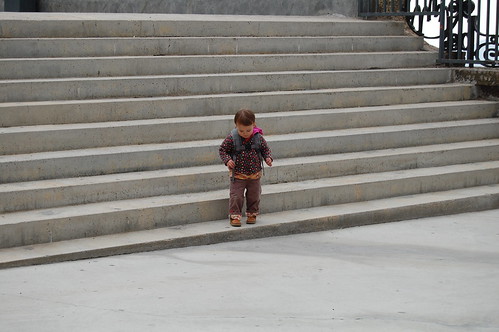Note from Beth: This past year has been a deep exploration into how nonprofits can use measurement and reflection to improve their practices as a networked nonprofit and social media. As part of my work at the Packard Foundation, I designed and facilitated several peer learning groups and exchanges. It was a fantastic laboratory to explore the power of peer learning and the right mix. Also, as a trainer how you create a co-learning opportunity versus the “sage on the stage.” I’ve been reflecting, doing an after action review to get a little deeper learning about how to design and facilitate peer learning. Meg Biallas agreed to write this post about what she learned.
Taking Baby Steps to Social Media Maturity with Your Peers, guest post by Meg Biallas, Fight Crime: Invest in Kids
I first heard about the “stages” of social media implementation from Beth: First, you crawl. Once you’re steady, you walk. Once the road is paved, you run for it! Last year, my organization took its first steps. We’re not “flying” yet, or even running, but it’s amazing what can happen in just a year with just a little help from your peers.
January: It Started With a Book
At Fight Crime: Invest in Kids, I wanted to know what worked in social media – and also what didn’t. At the annual staff retreat last January, we selected “The Networked Nonprofit” for our bookclub discussion. It was a fascinating look into how several nonprofits are using social media in ways that are both clever and effective. Over dinner and a bottle of California red (thanks to our San Fran staff!), we discussed how the organization might utilize social media in similar ways. The wheels were churning with staff at all levels and in all departments.
August: Stealth Measurement Takes Shape
In August, Fight Crime joined a peer learning experience led by Beth, acting as a Visiting Scholar with The Lucille Packard Foundation. Through monthly phone calls and a closed Facebook discussion group, I tested (“try to vary the type content each day of the week”). I asked questions (“Does posting on the weekend create more user engagement?”). I was put on the spot (Beth: “So what did you learn from that? What are you going to differently?”). I soon discovered that building a social media infrastructure wouldn’t be easy, but paving the road now would allow to drive more easily in the future.
Peer Learning Takeaways
Reporting begins with benchmarking. I’ve created my own deadlines for social media reports. Those are now included with our traditional media reports.Everything is an experiment, and flexibility is key. In October, Facebook introduced new features on the analytics pages. Beth adapted her lesson that month so we could focus on how the changes would affect our reporting process. Share successes and failures. Beth calls this the “try it and fix it” approach. Each month we went over our “homework” and I got to hear about effective strategies from other nonprofits.Each month we went over our “homework” and I got to hear about effective strategies from other nonprofits. One size does not fit all. If something isn’t working, abandon it.
December: Breaking Through to Stakeholders
As 2011 came to a close, our board members wanted to know what we were “doing” about social media. At the annual Board meeting, we presented our year-in-review of social media efforts. This
presentation was key to get upper management to think “digital first” for future campaigns.
What’s Next: 2012 Social Media Week DC
While the Packard learning group has formally ended, in many ways I’m just getting started. Next week, I’m moderating a panel for the first-ever Social Media Week in DC. The panelists include two other Packard grantees, Danielle Brigida (National Wildlife Federation), and Alison Carlman (Global Giving). I’m also thrilled to include Carie Lewis (Humane Society of the United States) and Alison McQuade (Emily’s List). We’ll be talking about how to report social media results to stakeholders. I’m excited for these panelists to share their success stories with the DC nonprofit community.
After just one year, social media is playing a front-and-center role within the organization. Social media doesn’t replace the traditional outreach methods, it only enhances those efforts.
What “stage” of social media is your organization or company at? What tools or experiments will you use to advance? How do you want to utilize social media in six months, or over the next year?
Meg Biallas is a Communications Associate with Fight Crime: Invest in Kids in Washington, D.C. She blogs about social media on her personal blog, Meg Goes To Washington. ). This post was originally published here.

